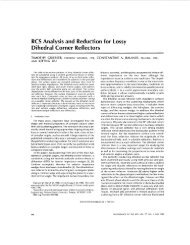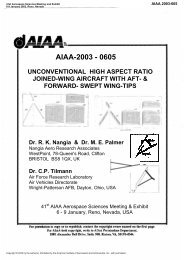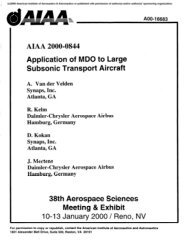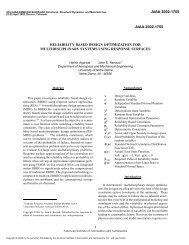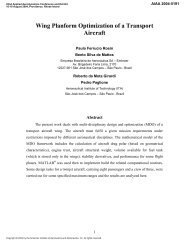The design report
The design report
The design report
You also want an ePaper? Increase the reach of your titles
YUMPU automatically turns print PDFs into web optimized ePapers that Google loves.
Empennage structure 4.1.3<br />
Preliminary and detail <strong>design</strong> (Empennage):<br />
Horizontal tail:<br />
Figure 4.1.301 shows the horizontal tail and the elevator assembly in CATIA<br />
As discussed earlier, the horizontal tail was to sit on the fuselage. We had to make sure<br />
there was no angle of incidence for the horizontal. A major issue while <strong>design</strong>ing the tail<br />
was its assembly with the fuselage. Details on how this problem was fixed are discussed<br />
later.<br />
<strong>The</strong> internal structure of the horizontal tail was similar to that of the wing. From the<br />
calculations done during conceptual <strong>design</strong> phase, the chord length was set to 180 mm.<br />
<strong>The</strong> entire horizontal tail was 763 mm long. Due to its size; all ribs were made of 2 mm<br />
ply to provide enough strength.<br />
<strong>The</strong> structure consisted of 11 ribs, 3 spars, 1 web spar, webbings, a servo plate and two<br />
blocks at the sides.<br />
Ribs:<br />
<strong>The</strong> 4 mm ribs on the ends were given flat bottom to avoid any angle of incidence. <strong>The</strong><br />
ribs in the middle had slots so that the servo plate could sit on it. <strong>The</strong> distance between<br />
each rib was 100 mm except the sides where the distance was 30 mm and in the middle<br />
where the distance was 50 mm. This was done to evenly distribute the spacing between<br />
the ribs. <strong>The</strong> rear end of the ribs in the middle had a 35 degree cut which gave enough<br />
space for the elevator deflection. Holes were cut in the ribs in order to save space and<br />
to connect wires to the battery.<br />
Spars:<br />
<strong>The</strong> structure consisted of 3 spars (one in the front, the other two at 25% of the chord).<br />
<strong>The</strong> spars were made of 6x6 mm pine rods.<br />
Web spar:<br />
This part did functions of both, the spar and the webbing. This part was at the rear side<br />
of the horizontal tail structure. <strong>The</strong> web spar was made of 3 mm ply. It had slots in it so<br />
that the ribs and the end plates could easily slide in. <strong>The</strong> main purpose of these slots<br />
was to avoid as much glue as possible and eliminate errors during fabrication.<br />
Webbing:<br />
3 mm balsa was used as webbing just to add more support to the structure.








![Introduction to RF Stealth [Book Review] - Antennas and ...](https://img.yumpu.com/16857890/1/190x245/introduction-to-rf-stealth-book-review-antennas-and-.jpg?quality=85)

